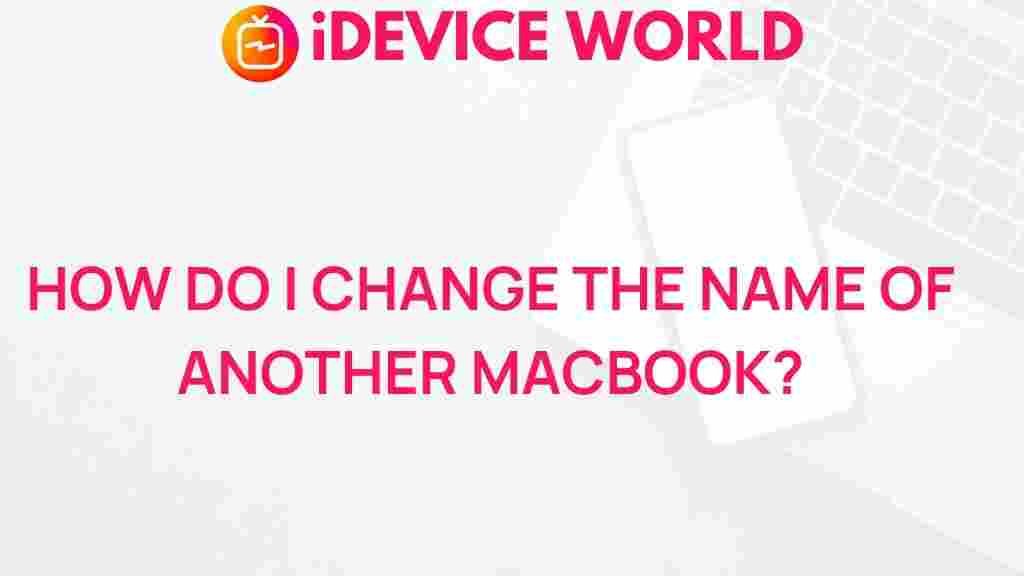How to Rename Your MacBook: A Step-by-Step Guide
Many MacBook users are unaware of the benefits of renaming their devices. Whether you’re setting up a new device, personalizing your tech, or managing multiple Macs, renaming your MacBook can make it easier to identify your device on a network, share files, and stay organized. In this guide, we’ll walk you through the simple steps to rename your MacBook, explore why it’s beneficial, and cover troubleshooting tips if you encounter any issues.
Why Rename Your MacBook?
Renaming your MacBook isn’t just about personalization; it can also be highly practical. Here are a few reasons why a MacBook name change can be beneficial:
- Network Organization: When sharing files or using AirDrop, an identifiable name prevents confusion, especially in shared spaces or offices.
- Device Management: Users with multiple Apple devices can keep their devices easily distinguishable by renaming each one.
- Security: A unique device name is less predictable and can provide an extra layer of security on public networks.
Preparing to Rename Your MacBook
Before starting, it’s helpful to know the type of MacBook you’re using, as the process may slightly differ between macOS versions. Additionally, make sure your MacBook is fully updated to avoid compatibility issues.
Steps to Rename Your MacBook
Renaming your MacBook is simple. Here’s a step-by-step guide to follow:
Step 1: Open System Preferences
Click on the Apple menu in the upper-left corner of your screen and select System Preferences. This is where you’ll find the main settings for your MacBook, including device name customization.
Step 2: Access Sharing Settings
In the System Preferences window, look for the Sharing option. It’s usually represented by a blue folder icon with a person silhouette. Click on it to open the sharing settings for your MacBook.
Step 3: Edit Computer Name
Once in the Sharing settings, you’ll see a field labeled Computer Name at the top. This field displays your MacBook’s current name. Click inside this field and type the new name you’d like for your MacBook. Press Enter to confirm.
Step 4: Close System Preferences
After you’ve entered your preferred name, you can close System Preferences. The name change takes effect immediately, meaning your MacBook will now appear with the new name on local networks and for file sharing.
Important Note on Apple ID and iCloud
If your MacBook is synced with your Apple ID, this name change will be reflected in iCloud and across any devices associated with your account. However, renaming your device doesn’t impact functionality, so it’s completely safe to do.
Troubleshooting Common Issues When Renaming a MacBook
While renaming a MacBook is straightforward, some users encounter issues. Here are common problems and solutions:
Device Name Not Updating on Network
If the new name isn’t showing up on your network, try the following:
- Restart your MacBook: Sometimes a reboot is all it takes for the change to be recognized.
- Check Network Settings: Go to System Preferences > Network and ensure your MacBook is correctly connected to the network.
- Reset Network Settings: If the name still doesn’t appear, resetting your network settings can resolve the issue.
Duplicate Device Names
If your network shows multiple devices with the same name, it’s likely that another device on the network shares that name. Here’s how to fix it:
- Choose a Unique Name: To avoid conflicts, choose a distinct name for each device.
- Check iCloud Settings: Ensure the name change is updated in iCloud by going to System Preferences > Apple ID > iCloud.
Device Name Reverting Back
If your MacBook reverts to the old name, it may be due to synchronization issues:
- Sign out and back into iCloud: Logging out and back into iCloud often resolves sync issues.
- Update macOS: Make sure your macOS is up-to-date, as older versions may have bugs affecting device renaming.
Alternative Ways to Identify Your MacBook
If renaming doesn’t completely solve your organization needs, you can explore other ways to distinguish your MacBook:
Customize Finder Settings
Another option is to add custom tags to your MacBook in Finder. Tags make it easy to locate specific devices or files. To do this:
- Open Finder and select your MacBook’s icon in the sidebar.
- Right-click and choose Tags, selecting a unique color or label.
Enable MacBook Icon in Sidebar
If you’d like to see your MacBook prominently in Finder, go to Finder Preferences > Sidebar and enable your device to appear in the Finder’s sidebar. This gives you quick access and helps with identification.
FAQs on Renaming Your MacBook
Will renaming my MacBook affect my files or settings?
No, renaming your MacBook only changes the name displayed on networks and in AirDrop. Your files, settings, and applications remain unaffected.
Can I change my MacBook’s name multiple times?
Yes, you can change your MacBook’s name as often as you like by following the same steps in the Sharing settings. Just remember, each change will reflect on connected devices.
Does renaming affect my Apple ID or iCloud account?
Renaming your MacBook does not impact your Apple ID. However, the new name may appear in your iCloud devices list, which helps identify each connected device easily.
Conclusion: Enjoy a Personalized MacBook Experience
Renaming your MacBook is a small but effective way to improve your device’s usability and organization. By following the steps in this guide, you’ll be able to rename your MacBook easily and troubleshoot any issues you might face. Personalizing your device not only enhances its functionality but also makes it feel uniquely yours. If you’d like more MacBook tips and tricks, check out our comprehensive MacBook resources.
For more information on how Apple devices interact within networks, you can also refer to Apple Support for additional guidance.
This article is in the category Guides & Tutorials and created by iDeciveWorld Team
